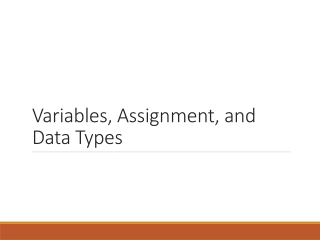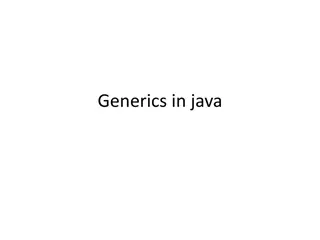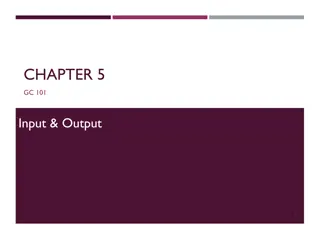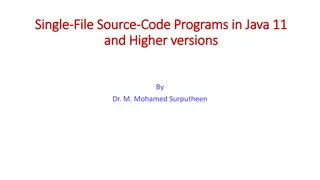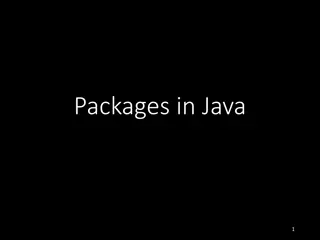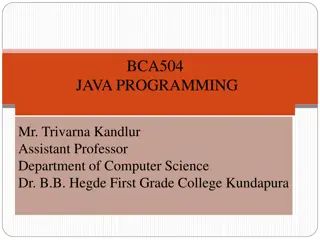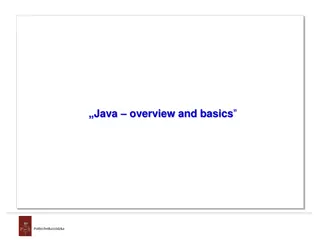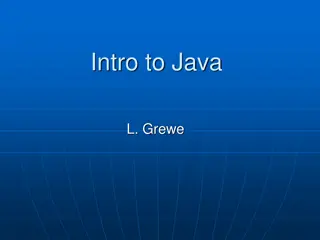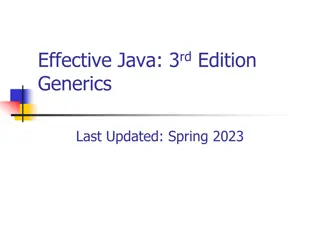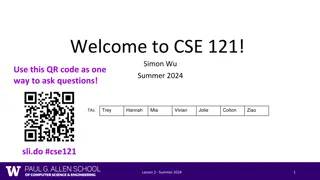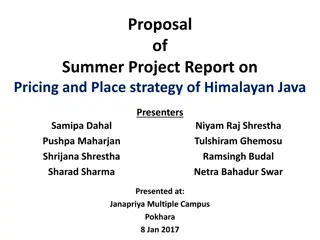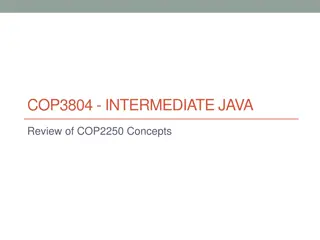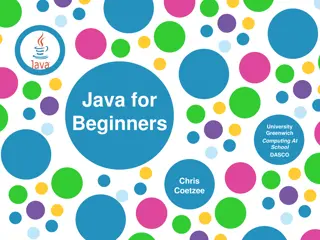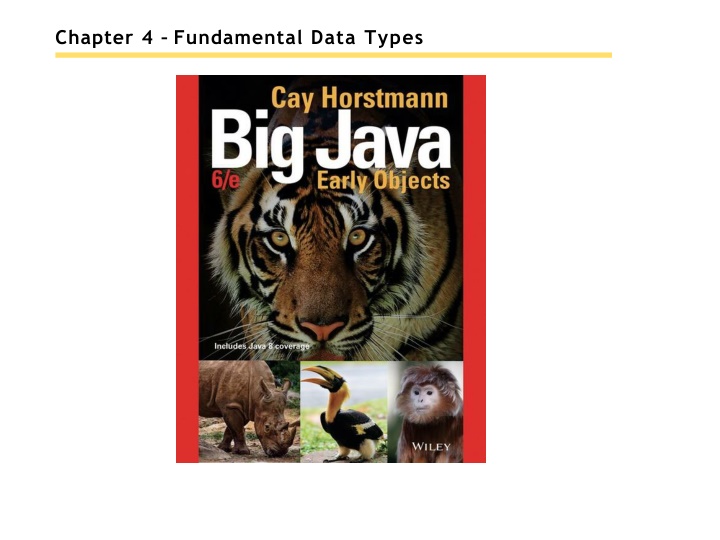
Fundamental Data Types in Java
Exploring the fundamental data types in Java, covering integer and floating-point numbers, limitations, causes for overflow and roundoff errors, proper use of constants, writing arithmetic expressions, manipulating character strings with the String type, and reading input/output operations. Understand Java's eight primitive types and the importance of choosing the right data type for computations to avoid errors and ensure accurate results.
Download Presentation

Please find below an Image/Link to download the presentation.
The content on the website is provided AS IS for your information and personal use only. It may not be sold, licensed, or shared on other websites without obtaining consent from the author. If you encounter any issues during the download, it is possible that the publisher has removed the file from their server.
You are allowed to download the files provided on this website for personal or commercial use, subject to the condition that they are used lawfully. All files are the property of their respective owners.
The content on the website is provided AS IS for your information and personal use only. It may not be sold, licensed, or shared on other websites without obtaining consent from the author.
E N D
Presentation Transcript
Chapter Goals To understand integer and floating-point numbers To recognize the limitations of the numeric types To become aware of causes for overflow and roundoff errors To understand the proper use of constants To write arithmetic expressions in Java To use the String type to manipulate character strings To write programs that read input and produce formatted output
Number Types Every value in Java is either: a reference to anobject one of the eight primitivetypes Java has eight primitive types: four integertypes two floating-pointtypes twoother
Primitive Types Type Description Size The integer type, with range -2,147,483,648 (Integer.MIN_VALUE) . . . 2,147,483,647 (Integer.MAX_VALUE) 4 int bytes 1 byte 2 bytes 8 bytes 8 bytes The type describing a single byte, with range -128 . . . 127 byte The short integer type, with range -32768 . . . 32767 short The long integer type, with range -9,223,372,036,854,775,808 . . . 9,223,372,036,854,775,807 The double-precision floating-point type, with a range of about 10308 and about 15 significant decimal digits long double 4 The single-precision floating-point type, with a range of about 1038 and about 7 significant decimal digits float bytes 2 Bytes 1bit The character type, representing code units in the Unicode encoding scheme char The type with the two truth values false and true boolean
Number Literals A number that appears in your code If it has a decimal, it is floating point If not, it is an integer
Overflow Generally use an int for integers Overflow occurs when The result of a computation exceeds the range for the numbertype Example int n = 1000000; System.out.println(n * n); // Prints 727379968, // which is clearly wrong 1012 is larger that the largest int The result is truncated to fit in anint No warning isgiven Solution: use long instead Generally do not have overflow with the double data type
Rounding Errors Rounding errors occur when an exact representation of a floating-point number is not possible. Floating-point numbers have limited precision. Not every value can be represented precisely, and roundoff errors can occur. Example double f = 4.35; System.out.println(100 * f); // Prints 434.99999999999994 Use doubletype in most cases
Constants: final Use symbolic names for all values, even those that appear obvious. A final variable is a constant Once its value has been set, it cannot bechanged Named constants make programs easier to read and maintain. Convention: use all-uppercase names for constants: final double QUARTER_VALUE = 0.25; final double DIME_VALUE = 0.1; final double NICKEL_VALUE = 0.05; final double PENNY_VALUE = 0.01; payment = dollars + quarters * QUARTER_VALUE + dimes * DIME_VALUE + nickels * NICKEL_VALUE + pennies * PENNY_VALUE;
Constants: static final If constant values are needed in several methods, Declare them together with the instance variables of aclass Tag them as staticand final The staticreserved word means that the constant belongs to the class Give static final constants public access to enable other classes to use them: Declaration of constants in the Math class public class Math { . . . public static final double E = 2.7182818284590452354; public static final double PI = 3.14159265358979323846; } Using a constant double circumference = Math.PI * diameter;
section_1/CashRegister.java 1 2 3 4 public class CashRegister 5 { 6 public static final double QUARTER_VALUE = 0.25; 7 public static final double DIME_VALUE = 0.1; 8 public static final double NICKEL_VALUE = 0.05; 9 public static final double PENNY_VALUE = 0.01; 10 11 12 13 14 15 16 17 18 19 20 21 22 23 24 25 26 27 28 29 30 31 32 33 34 35 @param quartersthe number of quarters in the payment /** A cash register totals up sales and computes changedue. */ private double purchase; private double payment; /** Constructs a cash register with no money init. */ public CashRegister() { purchase = 0; payment = 0; } /** Records the purchase price of anitem. @param amountthe price of the purchased item */ public void recordPurchase(double amount) { purchase = purchase + amount; } /** Processes the payment received from thecustomer. @param dollarsthe number of dollars in the payment
section_1/CashRegisterTester.java 1 2 3 4 public class CashRegisterTester 5 { 6 public static void main(String[] args) 7 { 8 CashRegister register = new CashRegister(); 9 10 11 12 13 14 15 16 17 18 19 20 21 22 23 24 } /** This class tests the CashRegisterclass. */ register.recordPurchase(0.75); register.recordPurchase(1.50); register.receivePayment(2, 0, 5, 0, 0); System.out.print("Change: "); System.out.println(register.giveChange()); System.out.println("Expected: 0.25"); register.recordPurchase(2.25); register.recordPurchase(19.25); register.receivePayment(23, 2, 0, 0, 0); System.out.print("Change: "); System.out.println(register.giveChange()); System.out.println("Expected: 2.0"); } Program Run: Change: 0.25 Expected: 0.25 Change: 2.0 Expected: 2.0
Self Check 4.1 Which are the most commonly used number types in Java? Answer: intand double
Self Check 4.2 Suppose you want to write a program that works with population data from various countries. Which Java data type should you use? Answer: The world s most populous country, China, has about 1.2 x 109 inhabitants. Therefore, individual population counts could be held in an int. However, the world population is over 6 109. If you compute totals or averages of multiple countries, you can exceed the largest int value. Therefore, double is a better choice. You could also use long, but there is no benefit because the exact population of a country is not known at any point in time.
Self Check 4.3 Which of the following initializations are incorrect, and why? 1. int dollars = 100.0; 2. double balance = 100; Answer: The first initialization is incorrect. The right hand side is a value of type double, and it is not legal to initialize an int variable with a double value. The second initialization is correct an int value can always be converted to a double.
Self Check 4.4 What is the difference between the following two statements? final double CM_PER_INCH = 2.54; and public static final double CM_PER_INCH = 2.54; Answer: The first declaration is used inside a method, the second inside a class.
Self Check 4.5 What is wrong with the following statement sequence? double diameter = . . .; double circumference = 3.14 * diameter; Answer: Two things 1. You should use a named constant, not the magic number 3.14 2. 3.14 is not an accurate representation of .
Arithmetic Operators Four basic operators: addition: + subtraction: - multiplication:* division:/ Expression: combination of variables, literals, operators, and/or method calls (a + b) / 2 Parentheses control the order of the computation (a + b) / 2 Multiplication and division have a higher precedence than addition and subtraction a + b / 2 Mixing integers and floating-point values in an arithmetic expression yields a floating- point value 7 + 4.0 is the floating-point value 11.0
Increment and Decrement The ++ operator adds 1 to a variable (increments) counter++;// Adds 1 to the variable counter The -- operator subtracts 1 from the variable (decrements) counter--; // Subtracts 1 from counter Figure 1 Incrementing a Variable
Integer Division and Remainder Division works as you would expect, as long as at least one of the numbers is a floating-point number. Example: all of the following evaluate to 1.75 7.0 /4.0 7 /4.0 7.0 /4 If both numbers are integers, the result is an integer. The remainder is discarded 7 / 4 evaluates to1 Use % operator to get the remainder with (pronounced "modulus", "modulo", or "mod") 7 % 4 is3
Integer Division and Remainder To determine the value in dollars and cents of 1729 pennies Obtain the dollars through an integer division by100 int dollars = pennies / 100; // Sets dollars to 17 To obtain the remainder, use the %operator int cents = pennies % 100; // Sets cents to 29 Integer division and the % operator yield the dollar and cent values of a piggybank full of pennies.
Powers and Roots Math class contains methods sqrt and pow to compute square roots and powers To take the square root of a number, use Math.sqrt; for example, Math.sqrt(x) To compute xn, you write Math.pow(x, n) To compute x2 it is significantly more efficient simply to compute x * x In Java, can be represented as b * Math.pow(1 + r / 100, n)
Converting Floating-Point Numbers to Integers -Cast The compiler disallows the assignment of a double to an int because it is potentially dangerous The fractional part islost The magnitude may be toolarge This is anerror double balance = total + tax; int dollars = balance; // Error: Cannot assign double to int Use the cast operator (int) to convert a convert floating-point value to an integer. double balance = total + tax; int dollars = ( i nt) balance; Cast discards fractional part You use a cast (typeName) to convert a value to a different type.
Converting Floating-Point Numbers to Integers- Rounding Math.round converts a floating-point number to nearest integer: long rounded = Math.round(balance); If balance is 13.75, then rounded is set to 14.
Self Check 4.6 A bank account earns interest once per year. In Java, how do you compute the interest earned in the first year? Assume variables percent and balance of type double have already been declared. Answer: double interest = balance * percent / 100;
Self Check 4.7 In Java, how do you compute the side length of a square whose area is stored in the variable area? Answer: double sideLength = Math.sqrt(area);
Self Check 4.8 The volume of a sphere is givenby If the radius is given by a variable radius of type double, write a Java expression for the volume. Answer: 4 * PI * Math.pow(radius, 3) / 3 or (4.0 / 3) * PI * Math.pow(radius, 3), but not (4 / 3) * PI * Math.pow(radius, 3)
Self Check 4.9 What are the values of 1729 / 100 and 1729 % 100? Answer: 17 and 29
Self Check 4.10 If n is a positive number, what is (n / 10) % 10? Answer: It is the second-to-last digit of n. For example, if n is 1729, then n / 10 is 172, and (n / 10) % 10 is 2.
Calling Static Methods Can not call a method on a number type double root = 2.sqrt(); // Error Use a staticmethod instead. A staticmethod does not operate on an object: double root = Math.sqrt(2); // Correct Static methods are declared inside classes Calling a static method:
Reading Input When a program asks for user input It should first print a message that tells the user which input isexpected System.out.print("Please enter the number of bottles: "); // Display prompt This message is called a prompt Use the print method, not println, to display the prompt Leave a space after thecolon System.in has minimal set of features Must be combined with other classes to beuseful Use a class called Scanner to read keyboard input.
Reading Input -Scanner To obtain a Scannerobject: Scanner in = new Scanner(System.in); Use the Scanner's nextInt method to read an integer value: System.out.print("Please enter the number of bottles: "); int bottles = in.nextInt(); When the nextIntmethod is called, The program waits until the user types a number and presses the Enter key; After the user supplies the input, the number is placed into the bottlesvariable; The programcontinues. Use the nextDouble method to read a floating-point number: System.out.print("Enter price: "); double price = in.nextDouble(); To use the Scanner class, import it by placing the following at the top of your program file: import java.util.Scanner;
Reading Input A supermarket scanner reads bar codes. The Java Scanner reads numbers and text.
Formatted Output Use the printf method to specify how values should be formatted. Printflets you print this Price per liter: 1.22 Instead of this Price per liter: 1.215962441314554 This command displays the price with two digits after the decimal point: System.out.printf("%.2f", price);
Formatted Output You can also specify a field width: System.out.printf("%10.2f", price); This prints 10 characters Six spaces followed by the four characters1.22 This command System.out.printf("Price per liter:%10.2f", price); Prints Price per liter: 1.22
Formatted Output You use the printf method to line up your output in neat columns.
Formatted Output You can print multiple values with a single call to the printf method. Example System.out.printf("Quantity: %d Total: %10.2f", quantity, total); Output explained:
section_3/Volume.java 1 import java.util.Scanner; 2 3 /** 4 This program prints the price per liter for a six-pack of cansand 5 a two-literbottle. 6 */ 7 public class Volume 8 { 9 public static void main(String[] args) 10 { 11 12 13 14 15 16 17 18 19 20 21 22 23 24 25 26 27 28 29 30 31 32 33 34 35 System.out.printf("Bottle price per liter: %8.2f", bottlePricePerLiter); Program Run: //Read price per pack Scanner in = new Scanner(System.in); System.out.print("Please enter the price for a six-pack: "); double packPrice = in.nextDouble(); //Read price per bottle System.out.print("Please enter the price for a two-liter bottle: "); double bottlePrice = in.nextDouble(); final double CANS_PER_PACK = 6; final double CAN_VOLUME = 0.355; //12 oz. = 0.355 l final double BOTTLE_VOLUME = 2; //Compute and print price per liter double packPricePerLiter = packPrice / (CANS_PER_PACK * CAN_VOLUME); double bottlePricePerLiter = bottlePrice / BOTTLE_VOLUME; System.out.printf("Pack price System.out.println(); per liter: %8.2f", packPricePerLiter); Please enter the price for a six-pack: 2.95 Please enter the price for a two-liter bottle: 2.85 Pack price per liter: Bottle price per liter: 1.38 1.43
Self Check 4.11 Write statements to prompt for and read the user s age using a Scanner variable named in. Answer: System.out.print("How old are you? "); int age = in.nextInt();
Self Check 4.12 What is wrong with the following statement sequence? System.out.print("Please enter the unit price: "); double unitPrice = in.nextDouble(); int quantity = in.nextInt(); Answer: There is no prompt that alerts the program user to enter the quantity.
Self Check 4.13 What is problematic about the following statement sequence? System.out.print("Please enter the unit price: "); double unitPrice = in.nextInt(); Answer: The second statement calls nextInt, not nextDouble. If the user were to enter a price such as 1.95, the program would be terminated with an input mismatch exception .
Self Check 4.14 What is problematic about the following statement sequence? System.out.print("Please enter the number of cans"); int cans = in.nextInt(); Answer: There is no colon and space at the end of the prompt. A dialog would look likethis: Please enter the number of cans6

